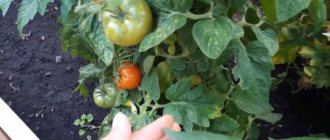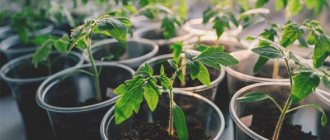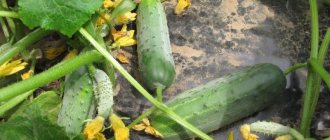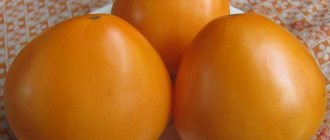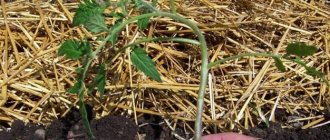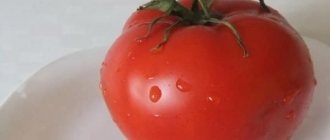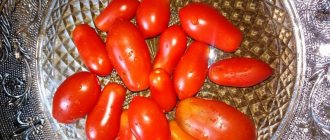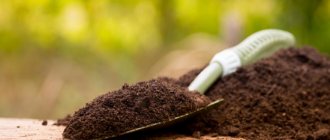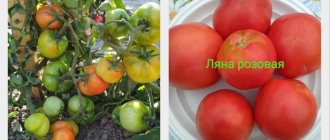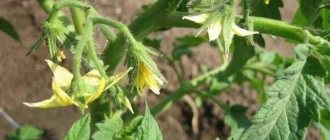» Vegetable growing » Tomatoes » Varietal characteristics of tomato Nepas
0
2387
Article rating
Those who grow tomatoes are always looking for a suitable option. The Nepas tomato is one of those varieties that, with minimal care and low material costs, always delight gardeners with a rich harvest.
- Advantages and disadvantages
- Rules for choosing a variety
- Features of cultivation
- Landing
- Care
- Reviews from gardeners
Varietal characteristics of tomato Nepas
Description and characteristics of the Nepas variety
This variety is protected from late blight, since it does not form a large number of stepsons and is well ventilated. On average, the height of the crop reaches 20-70 centimeters. When growing such tomatoes, their stems must be attached to supporting structures.
The resulting harvest can be used to make winter canned food or tomato paste. Vegetables can also be eaten fresh. On average, a summer resident can harvest 5.5 kilograms of tomatoes from 1 square meter.
Description of the variety
Tomato Nepas 7
First, you should pay attention to the fact that Nepas is several types of tomatoes that are similar in shape and size, but have different nuances of cultivation, and, accordingly, tastes.
Similar features of all types of Nepas tomato:
- Stepchildren are not required (this follows from the name), since there will be almost no stepsons. This allows the bushes not to suffer from, for example, late blight.
- The height of an adult bush is 30–70 cm.
- Stems of tall bushes (from 40 cm) need garter.
- On average, from one square meter of planting you can harvest from 5 kg of tomatoes.
- Tomatoes of any of the Nepas subspecies are suitable both for twists and for preparing complex dishes and sauces.
- Nepas tomatoes are always smooth and strong.
- For the most part, Nepas are early ripening.
- All Nepas tomatoes are well stored and transported.
- Tomatoes of this variety are resistant to temperature changes.
- Although the flavors are slightly different, they are not pronounced and do not have a sweetness.
But the color scheme is different: Nepas No. 2 has a pink tint, and Nepas No. 4, for example, is orange.
Varieties of tomato
The Nepas variety includes fourteen subspecies. Each of them has individual characteristics. The summer resident gets the opportunity to choose a plant based on the taste characteristics of ripe tomatoes, used in cooking, consumed fresh and canned, and based on its distinctive external features.
Nepas No. 2
This variety is mid-early; it pleases summer residents with the first harvest on average on the 105th day. Sometimes this period can vary within 5 days, up or down. The bush does not form stepsons. The plant is determinate and grows up to 0.7 meters in height, giving maximum yield in regions with high humidity and dry summer periods.
Ripe tomatoes of this variety have the following characteristics:
- raspberry colored skin;
- round shape;
- the skin structure is smooth;
- Basically, the mass of 1 vegetable ranges from 50 to 100 g.
This subspecies exhibits resistance to negative environmental factors. The average planting yield varies between 4-5 kg. Ripe vegetables are used to make pasta and preparations for the winter.
Nepas No. 3
This varietal subspecies is early ripening. The first harvest appears already on the 90th day. It is considered the best option for growing on unstable lands: it grows using the seedless method. The average height of the crop is set at half a meter. The plant requires moderate formation of stepsons. The fruits are juicy, their weight reaches 140 g.
Nepas No. 4
This subspecies is suitable for planting in open ground conditions, as well as in greenhouse structures. Culture is deterministic and does not require the formation of stepchildren. Ripe tomatoes are orangeish in color, the fruits weigh up to 70 g. The plant crop is resistant to blossom end and root rot.
Nepas No. 5
This subspecies is mid-early and forms fruits on the 105th day after planting in the soil. The standard crop develops to a height of 0.6 meters and is characterized by regular fruiting. After harvesting, the harvest can retain its freshness and attractive appearance for 14 days. Vegetables of this subspecies are dense with thickened skin; tomatoes are distinguished by an orangish tint and the presence of a pronounced spout.
Nepas No. 6
This subspecies is characterized by the fact that its average vegetable weighs from 80 g: the taste of tomatoes is rich and the pulp is dense. This varietal species is grown in open ground or in a greenhouse structure.
5-6 fruits are formed on bush clusters. On average, crop yield can reach 8 kg per 1 square meter. The hybrid exhibits resistance to a wide variety of tomato diseases and adapts well to conditions of increased or decreased temperatures. The main advantage of the crop is its good preservation of fruits and the possibility of their transportation.
See also
Characteristics and description of the Classic F1 tomato, recommendations for growing the variety
Read
Nepas No. 7
This variety is distinguished by its giant fruits. Its distinguishing feature is its mid-early ripening period. The harvest is formed in the last days of summer on the 105th day after planting seedlings in the soil or in a greenhouse structure. The culture is standard and determinate; the height of the bush can reach 0.8 meters.
Planting requires regular procedures for removing stepsons. The variety of tomatoes is quite large, their weight reaches 150-200 g. The vegetables are round in shape with a reddish smooth skin. They are characterized by a pronounced sweetish-sour taste. The average planting yield is 7 kg per 1 square meter. Varietal advantages include resistance to fusarium.
Nepas No. 8
This subspecies is characterized by mid-ripening and good growth when planted in open ground. Such a plant crop is limited in its growth process and is capable of rising 70 cm above the soil. The crop does not require the mandatory formation of stepsons. 5-6 fruits grow on the clusters.
The shape of the tomatoes is plum-shaped, the tip is slightly pointed. The color of the fruit is scarlet, their average weight is 50-70 g. The yield from 1 bush can vary from 5 to 7 kg per 1 square meter. This variety is resistant to fungi and can withstand lack of moisture and rainy seasons.
Nepas No. 9
An elongated subspecies that does not form stepsons is called Nepas No. 9. It will be the best option for open ground.
Growing in regions with continental climatic characteristics is considered a good solution.
A determinate plant crop reaches a height of 80 cm. Ripe vegetables have the following characteristics:
- shaped feature cylindrical, slightly elongated;
- the average weight of tomatoes is set at 60 g;
- The core of the fruit is fleshy.
This subspecies is resistant to most tomato diseases and produces a stable annual harvest.
Nepas No. 10
The plant of this species is early ripening. It belongs to determinant standard-type crops. The height of the bush does not exceed 70 cm. When planting, there is no need to remove stepsons. The fruits of the variety have the following characteristics:
- rounded shape;
- bright pink shade with thin yellowish stripes;
- the pulp has an average density;
- average vegetable weight 75 g;
- The taste of tomatoes is rich.
This variety can be used as a decorative element in the home.
Nepas No. 11
This is a non-growing indoor subspecies, characterized by ultra-earliness. The culture is small in size, and its height does not exceed 35 centimeters. Vegetables grow small in size, weighing on average 20 grams. The variety can be grown in the shade; it adapts well to the conditions of open ground and greenhouses.
Nepas No. 12
An ultra-early ripening hybrid plant will be the best option for the seedless cultivation method. The height of the crop reaches half a meter, and the weight of tomatoes is 150 g. The average yield of this hybrid subspecies is 7 kg per 1 square meter. The early ripening plant exhibits resistance to low temperatures and active changes in external temperature.
Nepas No. 13
Nepas 13 does not require the formation of bushes, since this plant is determinate and belongs to the standard species. Ripe vegetables are characterized by a plum-like shape. The fruits are reddish with a dense core and rich, sweetish taste. The harvest can be transported as it retains its freshness for 2 weeks.
See also
Description of the Honey Salute tomato and rules for germinating seedlings from seeds
Read
Nepas No. 14
This varietal subspecies has a medium-early ripening period. Most often it does not rise more than 0.8 meters. This species requires the removal of stepsons only if necessary.
Slightly flattened, round tomatoes weigh an average of 90 grams. In this case, the mass indicator can vary within 10 grams up and down. The variety is characterized by high taste qualities of ripened tomatoes and resistance to the negative effects of external factors.
Features of the variety
Due to the small number of stepsons, the bush is better ventilated: thanks to the structure of the stems, the indoor and garden hybrid does not suffer from late blight. The bushes grow from 20 to 70 cm in height. Planting of seedlings is carried out in early spring - the Nepas 3 or 4 tomato is unpretentious in care and temperature conditions in open areas.
Bushes in the garden are tied to arches, and if planting is carried out in boxes, special supports are attached to its base. Tomato Nepas 12 (non-grafting variety), like similar plants of the bred series, looks neat and bears fruit well. Thanks to the compactness of the bushes, you can increase the amount of harvest without expanding the beds.
The description of the hybrid suggests that the fruits are suitable for harvesting for the winter or making homemade tomato paste. The yield of all types of one series is 5-6 kg of tomatoes per 1 m2.
Advantages and disadvantages
The following advantages of this variety are highlighted:
- formation of stepson branches in small quantities, compact dimensional characteristics of plantings;
- resistance to temperature changes and to pathologies that affect other tomato varieties;
- getting an early harvest;
- increased productivity;
- the need to provide minimal care, the possibility of growing in greenhouse structures, in open ground conditions;
- high taste qualities of vegetables.
But there are also negative traits. The lack of rich taste and the small size of the fruits stand out separately.
Care
Before flowering, it is worth fertilizing the bushes with nitrogen fertilizers to achieve a large number of leaves.
Until the first fruits begin to appear, watering should be plentiful - twice a week. The fertilizing changes when the fruit appears; it should contain potassium and phosphorus. It is also worth taking care of supports for tall bushes in advance.
These rules will be relevant for all subspecies of the Nepas tomato variety. And even from them we can judge that all Nepas are truly unpretentious and are perfect not only for avid summer residents, but also for those who cannot devote time to gardening every day.
Variety selection
You should choose a varietal subspecies according to your own taste preferences. In order to eat fresh tomatoes or use them for making vegetable salads, the best options are No. 2 and No. 7. Nepas No. 3 also has suitable characteristics.
For preservation, Nepas No. 4 and Nepas No. 6 are considered the best options. These tomatoes are medium in size and have dense flesh.
Nepas No. 11 is suitable for decorating ready-made dishes. And No. 9 and No. 10 are characterized by decorative external features. Thanks to these qualities, these subspecies are used for preserving and decorating prepared festive dishes.
How to choose a variety
Non-grafting crops of the same series begin to grow equally quickly, so their choice depends only on the taste of the fruit.
How to choose a culture that suits its taste:
- Ripe fruits are good for adults and children - they contain vitamins and nutrients. For fresh consumption or for preparing summer salads, the Nepas 2 tomato with fruits of a rich crimson color and the 7th type of the series, characterized by large fruits - up to 200 g each, are suitable. The 3rd Nepas with tomatoes of a beautiful pink color has good taste. In open ground, Nepas 12 and 14 (sugar) ripen by the end of summer, and the ripe fruits have a distinct sweetish taste and dense flesh.
- For pickling and twisting for the winter. To prepare the preparations, you need medium-sized fruits with a hard skin and a dense core. Suitable for these purposes would be the Nepas 4 tomato with an orange-colored tomato, and the Nepas 6 tomato with fruits that stand out with a red nose.
- For decorating dishes. The indoor tomato Nepas 11 is suitable for decorating dishes and side dishes: thanks to the shape of the fruit, reminiscent of miniature cherry tomatoes. Hybrid bush No. 11 grows no higher than 35 cm and can be placed in the house.
- The elongated tomato Nepas 9 and striped tomato 10 are valued for their decorative appearance: tomatoes are used for twisting and decorating ready-made gourmet dishes.
- Variety No. 5 is distinguished by elongated fruits with an orange nose. Inside, the tomatoes are dense and juicy, which allows the harvested crop to be transported over long distances: the tomatoes do not spoil for a long time and retain their beautiful appearance.
Specifics of cultivation and care
Nepas tomatoes do not require any special care. Experienced summer residents do not advise sowing seedling material earlier than 2 months before the expected date of transplantation into the soil or greenhouse structure. The seed material must be soaked in potassium permanganate and sown to a depth of 10 millimeters. Before the sprout forms, the pot is covered with film.
The optimal temperature is between 20-25 degrees. Since the plant crop is resistant to low temperatures, it can be planted early in a greenhouse structure or under a film cover. You can plant 4 bushes at once on one meter. It is recommended to treat each depression with ash, humus and nitrogen compounds in moderate volumes.
During the growing season, fruits require abundant watering. The optimal option is considered to be a scheme twice in 7 days. Before flowering, the plant must be fertilized with nitrogenous fertilizers, which enable the planting to actively green up. When fruits begin to form, the plant crop requires potassium and phosphorus.
Features of cultivation
Plant productivity depends on proper care
Nepas tomatoes do not require specific care during the growing process, but some rules must be followed.
Landing
Nepas tomatoes can be grown without seedlings: the seeds are sent directly into prepared soil in a garden bed or in a greenhouse. Sandy loam soil is suitable for this, but if you plant a crop using the seedling method, you must not forget about important nuances:
- Seeds are selected only purchased from trusted suppliers. The price of one package varies from 25 to 150 rubles, depending on the number of seeds;
- the soil is prepared at the rate of 2 parts peat, 1 part humus and 1 part sawdust. Grinded chalk or ash is added to the mixture to destroy microbes;
():
In order to destroy pathogenic microflora in the soil, it must either be steamed at temperatures up to 80 degrees, or spilled with a 1% solution of potassium permanganate.
- The air temperature should not be below 20 °C, otherwise the seeds will not germinate. To maintain constant humidity, containers must be covered with glass or film until germination;
- 20-25 days after the emergence of seedlings, the plants dive.
- water with warm water;
- in the 3rd week of growth, apply the first fertilizing based on phosphates and potassium salts;
- when the seedlings reach a height of 15-18 cm, they are transplanted into a greenhouse or open ground.
Care
After replanting, you need to monitor the plant, inspect it for diseases or pests, water and fertilize on time. The bush should not be pinched, but if a large number of unnecessary leaves appear, they are removed. Bushes are tied up only when necessary: they are standard and low.
Plants are fertilized 3-4 times a season:
- after transplanting into the ground;
- during flowering;
- before fruiting;
- to prolong its process (if necessary).
Organic and mineral fertilizers must be alternated. Of the former, humus and ash are suitable for the Nepas tomato, of the latter - solutions based on phosphates and potassium salts (15 g of superphosphate and 10 g of potassium sulfate should be added to 10 liters of water).
Nepasy tomatoes - tomatoes without problems
The series consists of 14 varieties. Each Nepas has its own serial number. There is also a ancestor - Nepas without a number.
Tomato Nepas
Above is a still from a video presentation from Sedek. This company is the author and originator of the series. The company began registering its Nepas in the State Register in 2017 and continued until 2021, 2-4 varieties per year.
At the end of 2021, I became interested in these tomatoes. But before buying and growing, I always went to gardening forums. And gardeners spoke not very flatteringly about Nepas. There was an opinion that “Sedek” took old varieties with the same characteristics, combined them into a series and renamed them, without really bothering with the names.
I didn’t buy or grow it.
Interview with Yulia about Nepasy
But here, on Zen, I have already read more than one positive comment about Nepas from Julia. I decided to ask in more detail:
— Julia, you have already praised Nepasy several times. I want to ask about them for the article. Where did you find them, how did you recognize them?
- a good choice, I just read about standard tomatoes somewhere and they mentioned Nepas. Elsewhere I read comments about Sanka, which was tasteless, and they listed what could be planted instead and it was much better. They mentioned Nepas 3. So I went to look about these Nepas, and there are a whole bunch of them))
— Julia, which Nepas have you already tried?
— I chose Nepas 6, Nepas 4, Nepas 3, Nepas 14. So far I’ve tried 6 and 4. I liked them. 4 original in general. Orange hearts on a small bush.
“Are they really not stepchildren?” Or did they break something off?
- No, I didn’t break anything. Well, just as usual, I tore off the leaves from below so that they wouldn’t lie on the ground. Well, in my opinion, they need a garter, they are prolific and can break branches.
— What did you like about Nepas 6? What are its fruits?
— Shape, I like fruits with a spout)) Well, the taste pleasantly surprised me. I thought it would be plastic, as usual. And it turned out to be delicious. Certainly not like Sanka))) It tastes good, tomato-like, not sour or plastic. Nepas 4 grew on the street, I collected everything from it, there weren’t many of them, less than 6. I’ll probably plant a couple more bushes next time.
— Do their bushes have a lot of branches? Did the main stems even stand out? Or continuous thickets of shoots? And what is the size of the fruit?
— They stood out to me, the fruits are small, 80-100 grams. And the orange one is even smaller. They themselves grow into three trunks or two. What I thought was the stepchildren's climbers turned out to be flower brushes. There are other types of Nepas there. In general, like a good tomato “for every day” and early enough, they will do
Photo by Yulia: Nepas 6 was transplanted into a pot in the fall, the last harvest is ripening
Nepasa tomatoes: general and distinctive characteristics
Nepasy is a series of determinate tomatoes 50-70 cm high. Their common feature is that they form few stepsons, which simplifies care. Although you can plant them, then the tomatoes will grow larger and ripen earlier.
The series includes varieties with pink, yellow, red, striped fruits of various shapes (cream, hearts, round, flattened, with and without a spout). There are large ones for salads and small ones for pickling.
A selection of other tomatoes for open ground
Advantages of non-grafting varieties
In order for the maximum number of tomatoes of excellent taste to form and ripen on the bush during the season, the correct ratio of shoots and fruits is required. Excess foliage takes away from the plant the nutrients necessary for the full development of the tomato. In order to direct the strength of tomato bushes to ripening the crop, gardeners remove some of the shoots. First of all, this concerns stepsons - shoots growing in the axils of the main trunk.
This measure promotes the formation of the number of ovaries that can ripen before the onset of cold weather. In addition, removing side shoots allows you to maintain uniform illumination of the foliage throughout the season. Tomato varieties that do not require pinching are, to some extent, tomatoes for the lazy. Taking care of them requires less time and effort. The bushes stop growing on their own after setting several fruit clusters; the growth of their lateral shoots is limited.
Most varieties are early, low-growing tomatoes intended for open beds. Among the non-sapling varieties there are hybrids that are resistant to common diseases of the nightshade family. Based on reviews from gardeners, well-proven varieties can be identified.
Description of tomato variety Raspberry ringing and its characteristics
The Raspberry Zing tomato was included in the State Register of the Russian Federation relatively recently, in 2009. Recommended for private farms in all climatic regions. It can be grown both under film shelters and outside them. Raspberry ringing is a first generation hybrid (F1), which leaves its mark on its positive and negative sides. Thus, having high disease resistance, it does not transmit its properties through seeds, so you have to buy them in the store: collecting from your own harvest is pointless.
The hybrid is a determinate plant, but requires not only the formation of a bush, but also its tying. The bush is not tall, but in a greenhouse it can grow up to a meter. The leaves on the plant are ordinary, green in color. The root system is shallow. The first flower cluster is formed above the sixth leaf, the next ones - every two leaves. There are 5–6 tomatoes in a brush, a total of 7–9 brushes are formed. The fruit ripening period is early, about 100 days after germination, the main purpose is salad. Those specimens that fit in a standard glass jar can be preserved. Processing into juice, paste, sauces, etc. is also possible.
The brushes of this tomato are quite heavy, so you can’t do without a garter.
Tomatoes are round in shape, without ribs, of medium size: the mass of the main part of the fruit is about 150 g. The maximum value recorded under ideal conditions is 300 g. There are three or four seed nests, there are few seeds. The color when ripe is raspberry-pink. The taste is quite sweet, rated as excellent; gourmets say that watermelon notes can be traced in the taste and aroma. Productivity is relatively low: about 4.5 kg/m2. The fruits are well transported, but for these purposes they are removed slightly unripe, since their skin is quite thin: they “reach” perfectly during storage, and they are stored well.
general characteristics
Nepas is the result of selection by the domestic agricultural company Sedek. It is represented by a whole line of varietal subspecies, each of which is practically no different from its fellow.
The bush of all tomatoes has a standard shape and generally reaches a height of no more than 60 cm. All varieties are determinate and do not require staking. The stem is strong, medium-leafed, with green leaf blades of medium size.
Active growth of the crop is observed until the inflorescences appear. Each hybrid has a different shade of fruit and taste.
In terms of taste characteristics, Nepas tomatoes are classified as simple varieties. They contain little sugar, and therefore a noticeable sourness is felt during tasting. They are often used for making salads; many subspecies are ideal for canning. Some are also processed to produce tomato paste.
Productivity, ripening time
The plants are early ripening, making it possible to harvest already on the 90th day from the moment of planting. Productivity is standard for all low-growing nightshade crops and is quite acceptable for determinate low varieties. When properly caring for 1 sq.m. it is possible to obtain about 5.5 kg of tomatoes.
Growing regions
Nepas is a unique variety of tomatoes, suitable for growing in areas with absolutely any climate. It enters the fruiting phase even in regions with a relatively short summer period. Suitable for cultivation both in open ground and in greenhouse conditions.
Advantages and disadvantages
| pros | Minuses |
|
|
Origin of the variety
Caspar f1 tomatoes belong to the hybrid, high-yielding, standard, determinate, large-fruited tomato varieties of early ripening.
This form was developed in 2005 by the Dutch agrotechnical company Royal Sluis.
It has not passed varietal tests in our country, therefore it is not registered in the Russian State Register of Breeding Achievements. However, this does not prevent the cultivation of Caspar in all climatic conditions of the Russian Federation:
- In the South and in the Middle Zone, the variety is grown in open ground.
- In the North, Kaspar can fully realize his potential only in heated greenhouses and unheated greenhouses.
In 2014, the Royal Sluis company improved the hybrid by introducing its second generation, Caspar f2. It differs from the previous form in that it matures earlier.
In 2015, a new hybrid was tested in our country. Based on their results, it was given variety status and registered in the Russian State Register of Breeding Achievements. Officially, the culture is zoned in all regions of the Russian Federation, except for the Far North.
Growing seedlings
Deadlines
When determining the most favorable time for sowing seeds for seedlings, you should take into account the climate of the region and the principle of further cultivation - in open ground or a greenhouse. For areas where spring comes early, February is considered the optimal period for holding the event.
The territorial location in more severe conditions suggests rescheduling the work to the second half of March - the first week of April.
Preparing soil and seeds
You can purchase specialized soil for seedlings or make your own. In the latter case, you should combine sifted compost, soil from the garden and humus in equal proportions. This composition is prepared in the fall, then stored in the cold, which allows it to be disinfected. If this is not possible, in order to eliminate pathogenic microorganisms, the soil mixture is spilled with a solution of potassium permanganate.
Afterwards, ash (2 cups), superphosphate (60 g) and potassium sulfate (20 g) are added to 10 kg of starting material.
Seeds also require certain preparation, which is carried out according to the following principle:
- Poor quality specimens are rejected, as evidenced by signs of rotting and spotting.
- Disinfected by heat treatment. To do this, the seed material is wrapped in a gauze bag, placed in a thermos with hot liquid (temperature no more than 50 degrees) for a maximum of 30 minutes, then cooled in tap water.
- 7 days before the expected sowing date, place in a cloth moistened with a growth stimulator and place in a warm place. The “awakened” copies are used in the future.
Sowing technology
Step by step description:
- Place a drainage layer of fine gravel or eggshells on the bottom of the planting container, and spread the prepared soil on top. Sprinkle with warm water.
- Seeds are placed in holes 1 cm deep, re-moistened with a spray bottle, and sprinkled with loose soil.
- Cover with polyethylene or glass to create a greenhouse effect.
Care
To ensure rapid development of seedlings, it is recommended to maintain conditions within a certain norm:
- The optimal temperature is about 25°C. When the first leaves appear, the indicators are reduced to 18-20 °C.
- For full growth, plants must be provided with a sufficient degree of lighting for at least 16 hours a day. It is most convenient to use fluorescent lamps for this. Exposure to direct sunlight can negatively affect the condition of tomatoes.
- Before picking, the seedlings are not irrigated abundantly - once a week with a sprayer is enough. Stronger specimens are watered exclusively at the root.
Picking
Picking a “Non-Picking” tomato is carried out if it has 2 true leaves. During the procedure, the bushes are planted in separate containers or one container at a distance of 8-10 cm. After 10 days, the first fertilizing is done with a nitrogen-containing preparation, and subsequently fertilizers are applied at intervals of 2 weeks.
How and when to transplant to a permanent place
Before moving seedlings to the garden bed, they should first be hardened off. To do this, 1-2 weeks before the expected date, the temperature in the room is reduced to 12°C at night, and during the day the container is taken outside and left for 30 minutes (at a set temperature of not lower than 14°C).
Taking into account the fact that the variety is early ripening, transplantation into the ground is done 60-65 days from the moment the seeds are planted for seedlings, but no later than May 20-25
It is important to take weather conditions into account. To prevent young plants from dying as a result of spring frosts, they should be covered with spunbond or film
The procedure itself is carried out in the evening using the following technology:
- Dig holes at a distance of 40 cm and water generously.
- After complete absorption of moisture, the bushes are installed one at a time along with a lump of earth. Sprinkle with earth with the addition of vegetable compost, carefully compact around the perimeter, and re-irrigate. To ensure easy removal of seedlings from the container, the soil in it should also be pre-moistened.
Specifics of planting and caring for tomatoes in the Urals
To grow tomatoes in harsh climates, you need to choose the variety wisely and provide it with proper care. Seeds need to be planted in a timely manner. Watering, fertilizing, and formation of bushes are of great importance.
Watering mode
All plants require systematic watering. The soil is moistened for the first time a week after planting. Subsequently, the soil should be watered as it dries out. When the first fruits form, the systematicity of watering should be increased. Thanks to this, the plants will develop faster.
What to feed
It is recommended to feed the soil 3 times during the season. Wood ash is used before planting. Thanks to this, it is possible to achieve active root development. The following fertilizing is applied during flowering. This is also done 1-2 weeks before harvest.
Tomatoes are fertilized with the following means:
- potassium products – potassium sulfate;
- nitrogen preparations - urea;
- phosphorus substances - superphosphate.
Garter and bush formation
Tall types of tomatoes must be tied to fixing supports. Otherwise, there is a risk of damage to the bushes by wind or fruits. Tomatoes are secured using stakes that are placed near the plants. Their height depends on the size of the tomatoes - usually they take 1.5 meter pegs.
Trellis are often used as support. To do this, stretch a wire along each row. It should be strong enough.
Growing tomatoes in the Urals has a number of features. First of all, you should wisely choose a hybrid that is resistant to harsh climatic conditions. Complete and adequate care is of great importance.
Previous TomatoesHow to grow early ripening tomatoes: sowing dates and growing rules Next TomatoesHow to grow and care for a tomato tree
